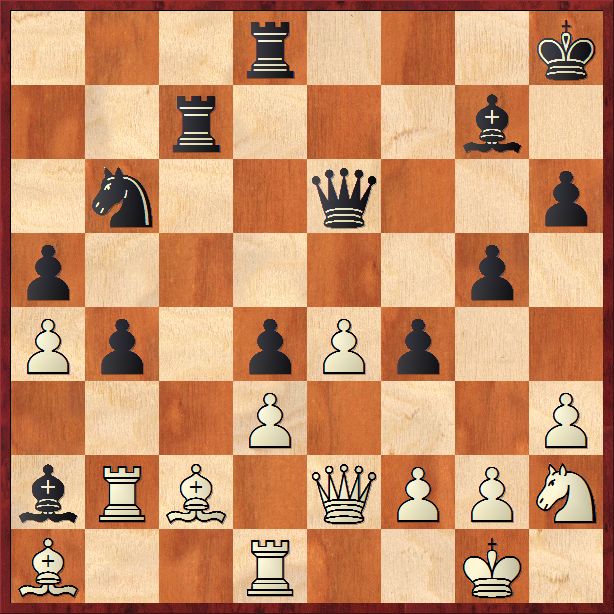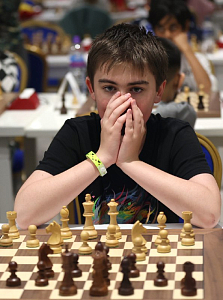13 July 2015
The Caro-Kann Lessons
Grandmaster Dmitry Kryakvin summarizes the results of the Russian Higher League.
So, the chess festival in Kaliningrad, organized by the Russian Chess Federation and the Charity Foundation of Elena and Gennady Timchenko as part of the international program "Chess in museums" has come to an end. For a number of years the Higher League was quite a problematic item of the national calendar, the Federation would always have a hard time organizing this event. Therefore, we would like to see this wonderful project on an ongoing basis, so that each year the Higher League gathers all the best players, except those who have already booked their cozy places in the Superfinal, of course.
So, a rather big victory of the younger generation of chess players has become the main outcome of the event as only Alexander Motylev, Marina Guseva and Evgenija Ovod are celebrating success out of all other seasoned masters of the chessboard. For Vladislav Artemiev, Ivan Bukavshin and Anastasia Savina it will be their first Superfinal battle, whereas Daniil Dubov, Ildar Khairullin, Alina Kashlinskaya and Anastasia Bodnaruk have already tasted what it is like to be faced off with the national team members.
At the finish of the men's section of the tournament the leaders played while keeping a careful eye to the pursuers, which is perfectly understandable. Alas, such memorable head-to-head battles for qualification as the blockbusters Shimanov-Potkin (Tyumen, 2012), Eliseev-Grachev (Ekaterinburg, 2013), Fedoseev-Zvjaginsev (Vladivostok, 2014) have not taken place. It is unfortunate that after the feasts that were seen in rounds 4-6 the limit of bright colors appears to have been exhausted as Caissa went somewhat greedy and trimmed the budget of black and white revelations. However, there was still no shortage of entertaining material.
The tie-break brought Vlad Artemiev into the top position in the overall standings. My congratulations belong both to the Omsk grandmaster and his first trainer Ivan Smykovsky, as well as to his current coach Pavel Maletin! It was only recently, just three years ago that the first-timer Vlad complained about his problems in the opening and how he was tired of going to school. But even then it was already quite obvious that he would come one day to the Higher League to claim victory!
By the way, taking this opportunity I would like to draw your attention to the following point. Numerous discussions were held on the sidelines of Loo-2015 about the reform of the Russian Chess Federation Grandmaster Schools and, in particular, about the hypothetical GM center in Siberia. Supporters strongly urged that the Siberian children needed similar level of education, while the opponents gravely declared that Siberia was not the first in the queue, and that the alleged head of the Center Pavel Maletin was too young and the Center should be headed by a chess classics of Chernyshov's or Yakovich's caliber. Children's chess in our country is definitely headed by very reputable, competent and caring people and they will sort the matters out, but since I have a pen in my hand, let me put in my two cents’ worth. Firstly, the legendary figure of the Russian chess Vera Tikhomirova would often open her speech by saying: "You should not do an injustice against the Urals and the Siberia!", and, secondly, a man has trained a winner of the Higher League, therefore you can trust him to train someone else.
Now let’s go back to the tournament itself.
Coincidentally, Artemiev got an excellent mark from his stern junior team coach Mikhail Kobalia, who did so by resigning his game.
Artemiev – Kobalia

As the chief coach of the junior team was performing brilliantly in Kaliningrad, the members of the junior national team were haunted by horror about what might happen if the Muscovite would qualify into the Superfinal because the Chita event coincided with the Youth Olympic Games in Mongolia.
26...f6! 27.Rb3 Rb7 28.Rdb1 Reb8 29.Qf3 (or 29.c4 Bd8) 29...Bd8 30.Qe2 Bf7 promised a very comfortable position now that the bishops have entered the game and Black was always ready to ward off the opponent's pawn storm and create his own counterplay on the queenside.
26...Qa7?! 27.Rb3 Rb7 28.Rdb1 Rd7 29.c4 bxc4 30.dxc4 Bd8 31.Rb8 f6 32.h4 Be7 33.R8b5 Bd8 34.Qd3 Bf7?!
This is yet another inaccuracy. The lifeless piece of iron fears nothing and offers to get at the a3-pawn by 34...Qa6 35.Bh3 Ra7.
35.Bh3

35...Be6?
This is a fatal mistake. 35...g5!? was recommended here by Sergei Shipov as a last resort and there are no any decisive threats by White just yet. However, let’s continue the line a little further 36.h5 Be6 37.f3 Qa6 38.Bf1 Ra7 39.R1b3, and I would sincerely regret the person who would face Vlad from behind such defensive formations.
The finish of the game turned out to be a lot less complicated.
36.Rb8 Kf8 37.g5! fxg5 38.Bxe6 Rxe6 39.Qh3 Re8 40.hxg5 Kg8 41.Ra8! Qxa8 42.Qxd7, and Black’s defensive lines have finally collapsed in view of 42...Bxg5 43.Rb7.
Artemiev could have been overtaken only by one person, i.e. by Ivan Bukavshin, who had so far developed a hurricane tempo. The author of this review communicated a lot with Vanya in the course of the latest Aeroflot open and that limited period of time was enough to have him convinced that nowadays the Togliatti native can perhaps be defeated only in cards. However, for me the process was less painful than for Rapport and all those whom Bukavshin would trash within the walls of the "Cosmos". You could have followed the execution of the technical phase with the bishop pair against Popov and the battle with Gordievsky in the review by Sergei Juryevich. There yet remains a final tango with Vadim Viktorovich Zvjaginsev.
Zvjaginsev – Bukavshin

Frankly speaking, White's position is such that any other player in the shoes of Vadik would have just resigned. However, the trainee of Mark Dvoretsky has always distinguished himself by a phenomenal resourcefulness, the ability to uncover the slightest possibility. Just try to keep up such a rating level with... uh... such a creative and original opening repertoire!
37.h4! gxh4 38.Nf3 h3 39.Nh4 Rc5!
Discouraging the white knight from immediate landing on f5. There remains just one move before the pawn finds itself on b3...
40.Qf3 Rdc8?!
This is the time control move! 40...hxg2! 41.Nf5 would have been a tougher option.
(bad is 41.Qxf4 Rh5 or 41.Kxg2 Rg8 42.Nf5 b3)
41...b3 42.Bxb3 (42.Bb1 Nxa4) 42...Bxb3 43.Rdb1 Rc3 and Black is up a piece.
41.Nf5 Be5
Black had no more spirit left to calculate the risky 41...Rxc2! 42.Rxc2 Rxc2 43.Bxd4 Be5! 44.Qxf4 Bxd4 45.Nxd4 Qg6 46.g3 Rc3 47.Qe5+ Qg7 48.Qd6 Nc8 with a large, close to decisive advantage. Now, however, White is able to extricate himself from trouble in a miraculous way.
42.Rxa2! Qxa2 43.Qxh3

The opponents agreed to a draw in this position in view of the following line: 43...Qxc2 44.Qxh6+ Kg8 45.Qg5+ Kf7 46.Qe7+.
By the way, 43...Qe6 is met with 44.Bb3! Qxb3 (after 44...Qf6? 45.Nxh6 Kg7 46.Ng4! Qg5 47.Nxe5 Qxe5 48.Qg4+ Kf6 49.g3 Black is already at risk of losing the game) 45.Qxh6+ Kg8 46.Qg5+ with a perpetual check. This escape is nothing short of being miraculous!
Very solid tournament finish was displayed by Alexander Motylev, who was greatly served by two white colors at the end. Ildar Khairullin also had to demonstrate a new idea to Alexander Riazantsev.
Riazantsev – Khairullin
Slav Defence
1.d4 d5 2.c4 c6 3.e3 Nf6 4.Nc3 a6 5.Nf3 Bf5
This is the most fashionable line in the Chebanenko Variation as, in fact, it affects the welfare of the invention by the great Moldovan coach in general.
6.Qb3 b5
You can defend the pawn in the Morozevich style, but then Alexander-the-Junior has had a couple of shot down fighter aircrafts on his account: 6...Ra7 7.Nh4 Bg6 8.a4! e6 9.a5 Nbd7 10.Nxg6 hxg6 11.Bd2 Bd6 12.g3 Bc7 13.Qa3 Ra8 14.Bg2, and White got the upper hand in a sharp fight that ensued (as in Riazantsev – Malakhov, 2014)
7.c5 a5
7...Nbd7 has been considered questionable ever since the game Vallejo - Svidler, 2006: 8.a4 e5 9.Qa3 Rc8 10.b4 g6 11.axb5 axb5 12.Nxb5! cxb5 13.Bxb5 e4 14.Ne5 Qc7 15.Qa7, when the Bronstein-like sacrifice on b5 helped White to achieve superiority, and an the end it were his connected passed pawns that decided the fate of the game.
8.Nh4 Bc8 9.Nf3 Bf5 10.Ne5

Having repeated the moves (Riazantsev has often resorted to this Capablanca’s advice as of lately), White transposed to the main line, which has recently seen the opening duel won by Maxim Matlakov as many as two times.
8.Ne5 a4 9.Qd1 g6 10.g4 Be6 11.Bg2 Bg7 12.f4 Qc8 13.h3 h5 14.g5 Nfd7 15.Nf3 h4 16.0–0 Na6 17.Bd2 Bf5 18.Qe2 Nb4 19.e4 dxe4 20.Nxe4 Bxe4 21.Qxe4 Nd5 22.f5, as in Matlakov – Malakhov, 2015 or 15...Bf5 16.Nh4 e6 17.0–0 Na6 18.e4 dxe4 19.Nxe4 Bxe4 20.Bxe4, as in Matlakov– Popov, 2015, both times with a sizeable advantage for White.
However, 10...g6!? was played quite unexpectedly
How come Khairullin has no fear of 11.Nхb5? It turns out that the blow runs into the counter 11...Nfd7! 12.Nхd7 Nхd7 13.Nc3 e5 with powerful compensation for the missing material. Without prior home preparation Alexander was unwilling to go for this position of maybe he knew that it was not worth going for. However, after
11.Qd1 Bg7 12.g4 Be6 13.Bg2 it turned out that, in fact, Black emerged up a tempo, the fact which he went on to capitalize upon:
13...h5! 14.g5 Nfd7 15.f4
After 15.Nd3 Bf5 16.f4 the Matlakov plan is no longer so strong as the d4-pawn will not be defended.
15...Nxe5 16.fxe5 Na6 17.0–0 Nc7 18.e4 0–0 19.Be3 Qd7, when White had to come up with a certain amount of accuracy. However, Ildar would not persist and the game ended in a fast draw.
In the women's section of the tournament the forced march at the finish was demonstrated by Marina Guseva, who won the first place quite deservedly. I am very happy for her and for her husband, my good friend Oleg Nechayev!
The Caro-Kann defense has traditionally been and still remains a formidable weapon in the hands of Guseva. Although in one of her recent articles on our website the triumphant of the Kaliningrad tournament was complaining about the favorite opening of Petrosian and Karpov, if you look up into the database it appears that more novelties than those by Marina for Black in the "Caro" have been introduced only by such an expert as Alexey Dreev.
Balaian – Guseva
Caro-Kann Defence
1.e4 c6 2.Nc3 d5 3.Nf3
I started sympathizing with Alina as early as here. Once the author of this article analyzed this line with the young Tyumen chess player Oleg Yuzhakov, and on the Dvorkovich-2014 Memorial Yuzhakov had a chance to test it against Guseva. Oleg was in a good shape as he had defeated Belous and made a few draws with some strong grandmasters, but in this case we screwed up, no doubt. It is very difficult to put into words what the connoisseur of the opening did to White’s position! To fight the Marina’s version of Caro-Kann one had perhaps better start with 1.Nf3!
3...Bg4
The modern line 3...Nf6 4.e5 Ne4 5.Ne2 Qb6 6.d4 e6 7.Nfg1 f6 8.f3 Ng5 9.exf6 gxf6 10.f4 Nf7 11.Nf3 Be7 was put to test in Kaliningrad as well (as in Kovalevskaya - Charochkina).
4.h3 Bxf3 5.Qxf3 e6
5...Nf6 6.d3 e6 7.Bd2 Qb6 8.0-0-0 d4 9.Ne2 c5 (as in Motylev - Najer, 2015) has been gaining popularity recently through the efforts of Evgeniy Najer, but Marina treads in the steps of Galkin, Dreev and the late Sasha Lastin.
6.d3 Nd7 7.Bd2 Bc5

8.0–0–0
The Black’s idea is in 8.Qg3 Bd4 (as in Fedorchuk - Galkin, 2014). This is how Alexey Dreev won a crucial game against Artemiev in the Kirov Rapid Grand Prix Final in 2013. Balaian comes up with a more aggressive plan, being inspired by the game Mastrovasilis - Short, 2011, where after 8...Ne7 9.h4 the Greek grandmaster won the game against the 1993 Challenger by direct attack. However, Marina’s comprehension of the Caro-Kann is superior to that of the Englishman who grew up on the Ruy Lopez.
8...Qf6! 9.Qxf6 Ngxf6 10.f4
What else can White wish for his happiness when he already has a bishop pair in the endgame? However...
10...h5! 11.g3
Balaian was clearly unwilling to go for 11.Be2 h4 12.Bf3, acknowledging the fact that Black had managed to seal the play on the kingside. On the other hand, the pawn move proved to be even more hazardous from the strategical point of view.
11...Bf2! 12.e5 Ng8 13.Ne2 Ne7 14.Bg2?
Better was 14.Rh2 Bb6 15.Bg2 Nf5, although even here Black features a very good game. Now Guseva seizes the opportunity to destroy the integrity of the white pawn chain.
14...Nf5 15.g4 Ne3 16.Bxe3 Bxe3+ 17.Kb1 g5!, and Black emerged up a pawn in a short while. The technical phase of the game was explained in great detail in the video review of our expert, therefore repeating here the analytical work of Sergei Shipov would be somewhat bad manners from my side.
The final battle in the Caro-Kann took place in the game against Anastasia Bodnaruk, who was to win the game by all means in order to achieve the overall victory in the tournament.
Bodnaruk – Guseva
Caro-Kann Defence
1.e4 c6 2.d4 d5 3.e5 Bf5 4.Nc3 e6 5.g4!?
Oh, those romantic chess years of 1990th! Back then every other elite game would mark the battle in this sharpest of tabiyas. On the attacking side were Anand, Topalov and Shirov, whereas Karpov, Bareev and Dreev were on the receiving end of the attack. Until the advent of powerful computers the final verdict on the reliability of Black’s formations was not declared.
5...Bg6 6.Nge2 c5 7.h4 h5 8.Nf4 Bh7
Black, in turn, is prepared to part ways with the first pawn, and then with the second one in order to obtain the active piece play.
9.Nxh5
9.g5 cxd4 10.Nb5 Be4 11.f3 Bf5 12.Nxd4 Ne7 has not gained a lot of popularity.
9...Nc6 10.dxc5 Bxc5

11.Bg2
A one-time success, which was seen in the game Naiditsch - Galkin, 2006 after 11.Bb5 Qc7 12.Bxc6+ Qxc6 13.Qf3 Kf8 14.Bg5 Rc8 15.0–0, is met nowadays by 15...Be7! 16.Rfe1 Bxg5 17.hxg5 Ne7 with a reasonable position.
11...Qa5!
Shirov defeated Topalov in 2008 after 11...Kf8 12.Bf4, while 11...Nd4 12.Bg5 Nxc2+ 13.Kf1 Qb6 14.Rc1 Qxb2 15.Rh3 has recently brought White victory in the game Shabalov - Linderman. Marina follows the legacy of another classic of Caro-Kann, my fellow countryman Maxim Turov.
12.0–0
After 12.a3?! Bd4 13.Nxg7+ Kf8 14.Nh5 Bxc3+ 15.bxc3 Qxc3+ 16.Bd2 Qxe5+ 17.Kf1 Bxc2 Maxim reaped a harvest of pawns without White getting any compensation for them (as in Dzhumaev - Turov, 2012).
12...0–0–0 13.Bd2
Although neither 13.Bf4 Nge7 nor 13.Nxg7 Bd4 look impressive, the attempt at the central blow in the game is warded off successfully by Black.
13...Nxe5 14.Nxd5

14...Qa4!
This subtle rejoinder exposes the vulnerability of the g4-pawn. Nastya has to throw more firewood into the fire.
15.b4 exd5 16.bxc5 Bxc2
This is a more accurate continuation than 16...Qxg4 17.Qxg4+ Nxg4 18.Nxg7.
17.Qe2 Qxg4 18.Qxg4+ Nxg4 19.Rfc1?
Correct is 19.Nxg7! Rh7 20.Bh3 Rxg7 21.f3 Bf5 22.fxg4 Bxg4 23.Kh2 that would have allowed White to rely on the might of the remote passed pawn and retain chances for the successful outcome of the game. Now White is in a bad shape.
19...Rxh5 20.Rxc2 Ne5 21.Ba5 Re8 22.Bxd5 Ne7 23.Bg2 N7c6 24.Bc3 Rxh4, and the pair of knights with a pawn prevailed over the pair of bishops.
The encounter Savina - Ovod was the main drama of the final round. Nastya continued fighting for medals, while Evgenija had no other choice but win, and she decided to go for it by resorting to 1...b7-b5?!? The results of Ovod’s opening were similar to those of the famous game Petrosian – Spassky.
Savina – Ovod
Polish Defense (termed so along the lines of Wikipedia)
1.d4 b5 2.e4 a6 3.Bd3 Bb7 4.Nf3 e6 5.a4 b4 6.0–0 Nf6 7.Nbd2 Be7 8.Re1 0–0 9.c4 d6 10.Qc2 h6 11.Nb3 a5 12.d5 exd5 13.exd5 Nfd7 14.Qe2 Re8

While Black is on the brink of disaster, the rival of Ovod, young Irina Drogovoz, is just an inch away from the massive success. Apart from just simply winning the game, Savina could have finished it in the style of classic masters: 15.Bxh6! gxh6 16.Qe3! (the pawn cannot be defended with the king as White’s knight is going to land on f5 to assist the queen) 16...Nf8 17.Nfd4, when neither defensive possibilities help black: 17...Nbd7 18.Qg3+ Kh8 (or 18...Bg5 19.Rxe8 Qxe8 20.f4) 19.Nf5 Bg5 20.Rxe8 Qxe8 21.f4, winning the sacrificed piece back with the crushing attack, or 17...Bc8 18.Qxh6 Bd7 19.Ne6! (there is also a rather simple win available to White after: 19.Re3 Bh4 20.Rae1) 19...fxe6 20.Re3 Bh4 21.Rh3 Qf6 22.Rg3+! Kf7 23.Rf3 Qxf3 24.gxf3 Bf6 25.Be4, and Black has no survival chances.
However, Nastya was carried away with another less efficient continuation: 15.Nbd4 Na6 16.Ne6 fxe6 17.Qxe6 + Kh8 18.Bxh6 Bf6, followed by both rivals having exchanged of a series of blunders in the heat of the fight and Evgenija prevailing in the end.
A fight between Kovalevskaya and Kashlinskaya was yet another important game of the last round. Ekaterina Valentinovna, who had also no other choice by win, decided to surprise her opponent with the exchange variation of Ruy Lopez, but at the end it petered out to a draw upon multiple exchanges.
Kovalevskaya – Kashlinskaya
Ruy Lopez
1.e4 e5 2.Nf3 Nc6 3.Bb5 a6 4.Bxc6 dxc6 5.0–0 Ne7!?
Alina has reacted in many different ways - 5...f6, 5...Qd6, and 5...Bd6, but this cute and rare line, invented by Igor Abramovich Zaitsev, was played by her for the first time. Black gives up his infantryman in order to get rich compensation for it.
6.Nxe5 Qd4 7.Qh5 g6

8.Nf3
The main continuation is 8.Qg5 Bg7 9.Nd3 f5! 10.e5 c5 11.b3! b6 12.Bb2 Qg4 13.Qe3! Nd5 14.Qe1! Bb7 15.f3 Qg5 16.Nc3, as in Motylev – Ponomariov, 2012. Black is not without compensation here, but "Stockfish" with "Houdini" do not believe it in full. However, being unprepared makes it impossible to come up with such smart twists over the board.
8...Qxe4 9.Qa5
However, a fresh idea by Naiditsch and Meier proved more than timely: 9.Nc3 Qf5 10.Qh4 Bg7 11.Re1 Be6 12.d3 Qg4 13.Qg5 Qxg5 14.Nxg5 Bf5 15.Bf4 h6 16.Nf3 Rc8 17.Re2 (as in Solak - Adhiban), when the resulting position with minor pressure in the endgame would be just to Kovalevskaya’s liking. Now, however, the position is a theoretical draw.
9...Bg4 10.Re1 Qd5 11.Qxc7 Bxf3 12.gxf3 Qxf3 13.Qxb7 Qg4+ 14.Kf1 Qh3+ 15.Kg1 Qg4+ 16.Kf1 Qh3+ 17.Kg1, and Alina took the second place.
I once again congratulate all the qualified heroes! We are looking forward to the Superfinal!






















